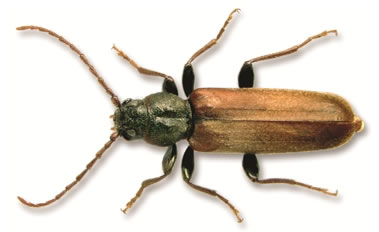Brown spruce longhorn beetle
The brown spruce longhorn beetle (Tetropium fuscum) is native to northern and central Europe, Russia and Japan.
In Canada, it infests spruce trees, such as red, white, black and Norway. Except for a small population near Calhoun, New Brunswick, the brown spruce longhorn beetle has only been found in Nova Scotia.
Woodpeckers and at least two species of parasitic wasps native to North America are known to prey on the brown spruce longhorn beetle.
Quick facts
- First identified in Halifax, Nova Scotia in 1999, the brown spruce longhorn beetle is a small (1-1.5 cm long), brown beetle.
- Using specimens from the Nova Scotia Museum of Natural History, the beetle was found to have been in Nova Scotia since 1990.
- It likely arrived in wood packaging material carried by container ships docked at the Port of Halifax, which is directly adjacent to Point Pleasant Park.
- Female beetles lay eggs in the bark of standing or recently felled spruce trees. Single eggs are usually laid (sometimes in clusters of up to 10) and hatch in 10-14 days.
- Larvae bore into the live bark to feed. Tunnels are packed with sawdust-like excrement.
- Adults live for about two weeks and can be found from late May to August.

Brown spruce longhorn beetle (adult).
Impacts
- The brown spruce longhorn beetle spreads naturally and through the movement of infested material such as spruce firewood and spruce logs being shipped to mills.
- It prefers and survives better in stressed, weakened and recently fallen spruce trees.
- It can infest healthy spruce, but this is rare unless populations are high.
- Mature spruce forests under stress from disturbances such as drought, defoliation, strong winds are at risk of a brown spruce longhorn beetle infestation.
- Once infested, spruce trees die within one to five years.
CFS scientific research
Through various studies, scientists working at the Atlantic Forestry Centre, Canadian Forest Service (CFS) have expanded what is known about the brown spruce longhorn beetle.
- Male beetles emit a pheromone called fuscumol that synergizes the attraction of both sexes to the smell of stressed spruce trees.
- Fuscumol, in association with host tree volatiles, is used as bait in traps to monitor beetle distribution and spread in Canada.
- Female beetles will lay eggs on healthy trees if they have no choice, but the larvae usually die unless the health of the tree is compromised.
- Adult beetles are capable of flying long distances, but most fly only a few hundred metres.
The Canadian Forest Service has also created a brown spruce longhorn beetle risk analysis model, which enables forest managers to predict areas that are more vulnerable to infestation or more likely to have existing populations. Researchers input forest types, locations where the beetle has been detected, places where wood is moved (e.g., lumber mills and campgrounds), the location of ports and other values with the aim of identifying areas where the brown spruce longhorn beetle is more likely to be found.
Working collaboratively to develop solutions
Through the Canadian Forest Service, Natural Resources Canada has partnered with the Canadian Food Inspection Agency (CFIA), Parks Canada, the governments of New Brunswick and Nova Scotia, forest industry and private woodlots owners to respond to detections of brown spruce longhorn beetle populations outside of Nova Scotia, where this insect is regulated by the CFIA. Best practices have been shared with private woodlot owners to reduce the beetle’s impact and spread.
Have questions?
Send questions or comments to CFS questions with “brown spruce longhorn beetle” in the subject heading.
Page details
- Date modified: